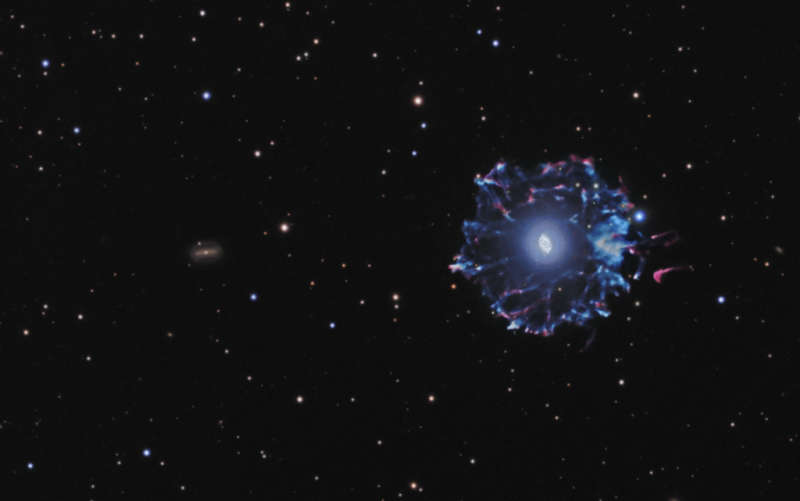Credit & Copyright: Josh Smith
Explanation:
The Cat's
Eye Nebula (NGC 6543) is one of the best known
planetary nebulae in the sky.
Its more
familiar outlines are seen in the brighter central region of
the nebula in this impressive wide-angle view.
But the composite image combines many
short and long exposures to also reveal an extremely faint outer halo.
At an estimated distance of 3,000 light-years, the
faint outer halo is over 5 light-years across.
Planetary nebulae have long been appreciated as a final phase
in the life of a sun-like star.
More recently, some planetary nebulae are found to
have halos like
this one, likely formed of material shrugged off during
earlier episodes in the star's evolution.
While the planetary
nebula phase is thought to last for around 10,000 years,
astronomers estimate the age of the outer filamentary portions
of this halo to be 50,000 to 90,000 years.
Visible on the left, some 50 million light-years beyond
the watchful planetary nebula, lies spiral galaxy NGC 6552.
1998 1999 2000 2001 2002 2003 2004 2005 2006 2007 2008 2009 2010 2011 2012 2013 2014 2015 2016 2017 2018 2019 2020 2021 2022 2023 2024 |
Январь Февраль Март Апрель Май Июнь Июль Август Сентябрь Октябрь Ноябрь Декабрь |
NASA Web Site Statements, Warnings, and Disclaimers
NASA Official: Jay Norris. Specific rights apply.
A service of: LHEA at NASA / GSFC
& Michigan Tech. U.
|
Публикации с ключевыми словами:
Cat's Eye Nebula - planetary nebula - halo - туманность Кошачий глаз - Планетарная туманность - гало
Публикации со словами: Cat's Eye Nebula - planetary nebula - halo - туманность Кошачий глаз - Планетарная туманность - гало | |
См. также:
Все публикации на ту же тему >> | |
